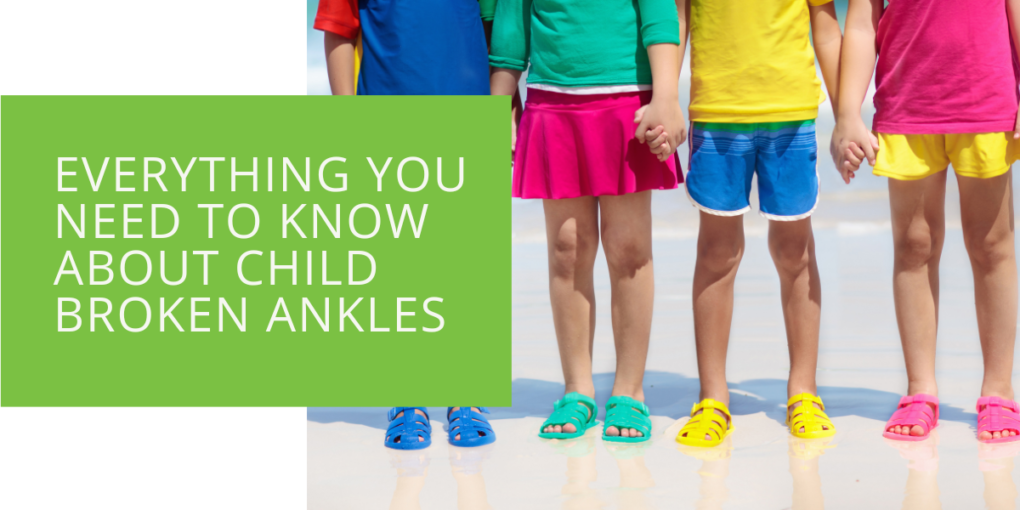Everything You Need to Know About Child Broken Ankles
As a parent, it's always concerning to see your child get hurt, especially when it comes to broken bones. When it comes to children, broken ankles are a common injury, and it's important to understand the signs, causes, and treatments to ensure your child receives the appropriate care. In this article, we'll go over everything you need to know about child broken ankles, including diagnosis, treatment options, and prevention tips so that you can keep your child's ankle health in check.
What is a Child Broken Ankle?
A broken ankle, also known as an ankle fracture, is a break in one or more of the bones that make up the ankle joint, including the tibia and fibula. Children are more prone to breaking the growth plate, which is the area of the bone where growth occurs. A child's growth plate is weaker than the rest of the bone, which means that a child may be more prone to a growth plate fracture than a full bone fracture.

Causes and Symptoms
A child's broken ankle can be caused by a range of activities such as sports, play, or even a simple fall. Some of the most common activities that can lead to a ankle fracture in children include:
- Playing contact sports such as soccer, football, or basketball
- Jumping from a high surface, such as a tree or playground equipment
- Participating in activities that involve sudden stops or changes in direction, such as skateboarding or rollerblading
- Walking or running on uneven surfaces, such as rocks or gravel
- Slipping or tripping on a wet or slippery surface
Certain factors can also increase a child's risk. For example, children who are overweight or obese may be more likely to experience a fracture due to the increased pressure on the bones and joints. Children with low bone density may also be more prone to broken bones.
Symptoms in children can include swelling, bruising, difficulty walking, and pain that may get worse when the ankle is moved. Some children may also experience a cracking or popping sound when the ankle is injured. If your child experiences any of these symptoms, it's important to seek medical attention from a podiatrist as soon as possible. The podiatrist will be able to diagnose the injury and recommend the appropriate course of treatment.

Diagnosis
A podiatrist will diagnose a fractured ankle in children through exams and tests. An X-ray is typically the first step in diagnosing, but in some cases, a CT scan or MRI may be necessary to get a more detailed view of the fracture. The podiatrist will look for signs of broken bones, displacement, and any other potential damage.
Treatment Options
The treatment for a child's broken ankle will depend on the severity of the fracture. In some cases, a simple brace or cast may be necessary to treat the fracture. Other cases may require surgery to repair the damage. For non-surgical treatments, the podiatrist may recommend RICE (rest, ice, compression, elevation), physical therapy, and rehabilitation exercises to help your child recover.
Non-Surgical Treatment Options
For minor ankle fractures, a cast or brace may be sufficient for the bone to heal. The podiatrist will likely recommend RICE (rest, ice, compression, elevation) to help control swelling and inflammation. In more severe cases, the child may need crutches to avoid placing weight on the injured ankle. Physical therapy and rehabilitation exercises may also be recommended to promote a full recovery.
Surgical Treatment Options
If surgery is necessary, the podiatrist will discuss the risks and benefits of the procedure with you. Surgery may be necessary if the fracture is severe, or if the bone is out of place. The podiatrist may use pins, screws, or plates to fix the bones back together. After surgery, the child will need to wear a cast or brace and may need physical therapy.

Recovery Process
The recovery process for a child's broken ankle can vary depending on the severity of the fracture. In general, it can take up to 6-8 weeks for the bones to heal. During this time, the child may need to wear a cast or brace and avoid putting weight on the injured ankle. The podiatrist may recommend physical therapy and rehabilitation exercises to help promote a full recovery.
Prevention and Risk Reduction
Preventing a child's broken ankle involves taking a few precautionary measures. Children should wear proper footwear that is supportive and provides protection. Additionally, when participating in sports or activities, children should wear the appropriate protective gear, such as ankle braces or shin guards. It's also important to make sure that play areas are safe and free of hazards that could cause a fall.
Parents can also reduce the risk by encouraging safe behaviors, such as avoiding running on slippery surfaces or jumping from high places. It's also important to ensure that children get plenty of physical activity to help build strong bones and muscles, which can reduce the risk of injury.
Conclusion
It can be a scary experience for both the child and the parents. However, with proper diagnosis and treatment from a podiatrist, most children make a full recovery. If you suspect that your child may have a broken ankle, it's important to seek medical attention right away. With the right care and treatment, your child can be on the road to a full recovery. Remember, prevention is key, so encourage safe behaviors and activities to keep your child's ankle health in check.

